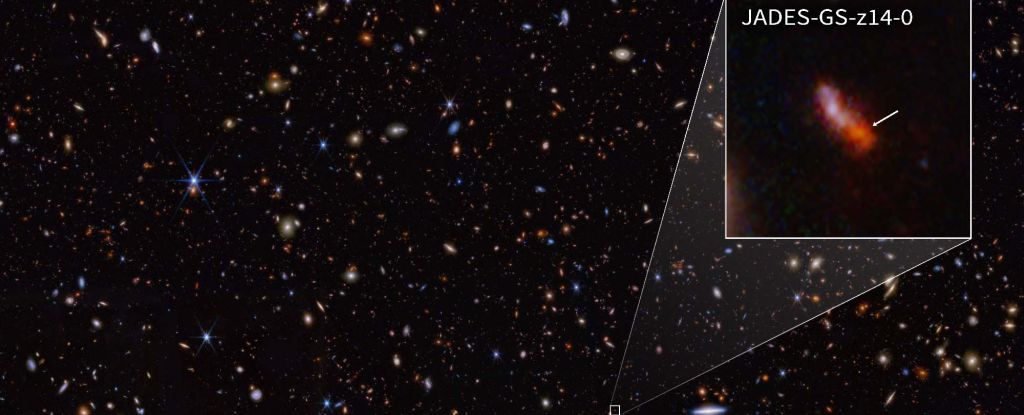A newly discovered galaxy has just broken the record for the earliest ever observed, posing a major challenge to our current models of galaxy formation.
It’s called JADES-GS-z14-0, and it shines brightly in the early universe, as it appeared less than 300 million years after the Big Bang. A second recent discovery, called JADES-GS-z14-1, was confirmed to be almost as distant.
The findings, astronomers say, are now “unequivocal,” meaning Cosmic Dawn may have something to “clarify.”
“In January 2024, NIRSpec observed this galaxy, JADES-GS-z14-0, for almost ten hours, and when the spectrum was first processed there was unequivocal evidence that the galaxy was indeed at a redshift of 14.32 , which breaks the previous most distant galaxy record,” said astronomers Stefano Carniani of the Scuola Normale Superiore in Italy and Kevin Heinlein of the University of Arizona.
“From the images, the source is found to be more than 1,600 light-years across, proving that the light we see comes mostly from young stars, rather than radiation from the vicinity of an accreting supermassive black hole.”
“This much starlight suggests that the galaxy is several hundred million times the mass of the Sun! This begs the question: How could nature create such a bright, massive and large galaxy in less than 300 million years?’
Three separate articles have been written on the subject, with one recently published in Nature.
Two others on the arXiv are yet to be peer-reviewed, but all three have the same conclusion: JADES-GS-z14-0 is definitely there, a shining data point that represents a new way forward for understanding how the universe formed, in the very beginning .
Until relatively recently, we had very little concrete knowledge of the period known as the Cosmic Dawn, the first billion or so years after the Big Bang 13.8 billion years ago. This is because the early universe was filled with a haze of neutral hydrogen that scattered light, preventing it from spreading.
This fog did not last; it was ionized and cleared by ultraviolet light emitted by objects in the early universe, and by the end of Cosmic Dawn space was transparent.
By then, though, there were already a whole bunch of stars and galaxies hanging around. If we want to know how it all came to be, we need to be able to peer into the fog.
This is one of the things that JWST, with its powerful infrared eyes, was designed to do. Infrared radiation can pass through dense media that other light cannot, its long wavelengths can pass with minimal scattering.
He conducted the JWST Advanced Deep Extragalactic Survey (JADES), searching for objects in the first 650 million years after the Big Bang, with very interesting results.
One thing we repeatedly find is large objects much earlier than we expect. This was pretty mind-blowing because we were working under the assumption that things like supermassive black holes and galaxies take a long time to form – much longer than the time frame we observe them on.
But the JADES-GS-z14-0 takes the cake. It is very large and very bright, not at all what astronomers predicted galaxies in the early universe looked like.
First, its size indicates that most of the light must come from stars, rather than a glow from space around a growing supermassive black hole.

Analysis of its light reveals the presence of a lot of dust and oxygen, which is unexpected so early. Such heavy elements would have to be made inside stars, which would then have to explode. These characteristics suggest that several generations of massive stars must have lived and died already 300 million years after the Big Bang.
Given that the largest stars today have lifespans of only about a few million years, it’s not impossible, but it’s still not exactly what astronomers expected to find.
Taken together, the galaxy suggests we need to rethink the early Universe, showing that the large number of light sources we see there cannot be fully explained by accreting black holes. Somehow, large, bright, well-formed galaxies can come together at the beginning of the Cosmic Dawn.
“JADES-GS-z14-0 is now becoming the archetype of this phenomenon,” Carniani said. “It’s amazing that the universe could create such a galaxy in just 300 million years.
The paper on the discovery, led by Carniani, was published in Nature. Other papers studying the properties of galaxy light can be found on arXiv here and here.
An earlier version of this article was published in May 2024.



